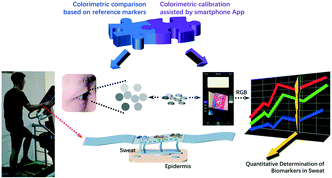A thread/fabric-based band as a flexible and wearable microfluidic device for sweat sensing and monitoring†
Abstract
Flexible biosensors for monitoring systems have emerged as a promising portable diagnostics platform due to their potential for in situ point-of-care (POC) analytic devices. Assessment of biological analytes in sweat can provide essential information for human physiology. Conventional measurements rely on laboratory equipment. This work exploits an alternative approach for epidermal sweat sensing and detection through a wearable microfluidic thread/fabric-based analytical device (μTFAD). This μTFAD is a flexible and skin-mounted band that integrates hydrophilic dot-patterns with a hydrophobic surface via embroidering thread into fabric. After chromogenic reaction treatment, the thread-embroidered patterns serve as the detection zones for sweat transferred by the hydrophilic threads, enabling precise analysis of local sweat loss, pH and concentrations of chloride and glucose in sweat. Colorimetric reference markers embroidered surrounding the working dots provide accurate data readout either by apparent color comparison or by digital acquirement through smartphone-assisted calibration plots. On-body tests were conducted on five healthy volunteers. Detection results of pH, chloride and glucose in sweat from the volunteers were 5.0–6.0, 25–80 mM and 50–200 μM by apparent color comparison with reference markers through direct visual observation. Similar results of 5.47–6.30, 50–77 mM and 47–66 μM for pH, chloride and glucose were obtained through calibration plots based on the RGB values from the smartphone app Lanse®. The limit of detection (LOD) is 10 mM for chloride concentration, 4.0–9.0 for pH and 10 μM for glucose concentration, respectively. For local sweat loss, it is found that the forehead is the region of heavy sweat loss. Sweat secretion is a cumulating process with a lower sweat rate at the beginning which increases as body movement continues along with increased heat production. These results demonstrate the capability and availability of our sensing device for quantitative detection of multiple biomarkers in sweat, suggesting the great potential for development of feasible non-invasive biosensors, with a similar performance to conventional measurements.



 Please wait while we load your content...
Please wait while we load your content...